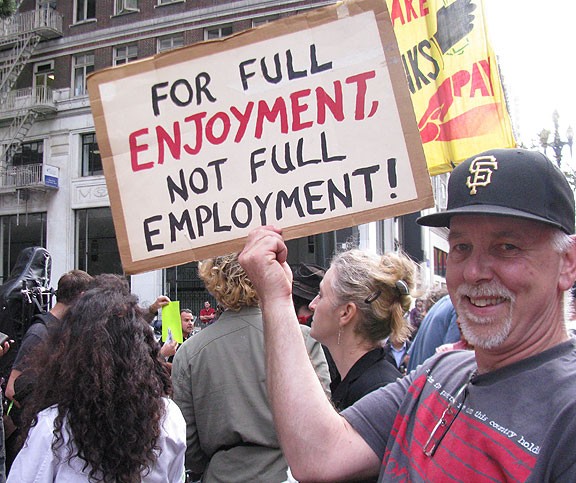
A few years ago… still relevant!
It’s the end of the year 2021. Expectations of an end to life as we knew it—resulting from the pandemic—have not materialized. Even the end of the pandemic has not materialized, though just a few months ago it seemed it was winding down. Climate change continues to barrel down on us with no sign that the death-grip of the fossil fuel industries is loosening its hold on the political class. At least we’ve had a miraculously wet and snowy December in northern California, delaying by another season the relentless drying out that will eventually turn much of California into a desert.
I’ve written in previous posts about the ruminations of Franco “Bifo” Berardi. His latest book, The Third Unconscious, sparked my curiosity. Like previous recent books, he is trying to find a path out of the depressive world of semiotic capitalism we’re all trapped in. His earlier analysis of the replacement of conjunction by connection (essentially the swapping of face-to-face lived experience for the programmed communications of online “connection”) provides some foundation for his new effort to understand what is happening to our deeper sense of life during these pandemic times. He recognizes that there is a deep division underway, a cultural split that gets the name “schismogenesis,” meaning a deliberate differentiation, where different populations assert their difference from each other. (Graeber and Wengrow make use of this term in The Dawn of Everything too, referring to the apparent common reality that people who live near each other tend, over time, to choose opposite traits and qualities of the other.) In Bifo’s book, he is referring to the emergent culture that, if it finds its collective voice, if its subjectivity emerges, may lead to a revolution worthy of its name. As he notes, as a result of the pandemic’s abrupt alteration of the rhythms of daily life,
…we have moved beyond the labyrinth; we have silently made that move that fifty years of loquacious struggles have failed to carry out. The disruption has finally happened, but it has been a process without subjectivity. (p. 39)
In his most optimistic moments he says things like
They [we?] are weaving the fabric of the emergent cosmos that may become recognizable beyond the threshold: that new cosmos which is already schismogenetically diverging from the dying form of the old cosmos, from the chaotic trap of the rules that used to hold the world together by destroying it. (p. 12)
… an alternative does exist: it is based on the liberation from the obsession with economic growth; it is based on the redistribution of resources, on the reduction of labor time, and on the expansion of time dedicated to the free activity of teaching, researching, healing and taking care. (p. 130)
Elsewhere he notes that “it is impossible to separate climate justice from a world-wide program of redistribution of wealth and resources,” which if we were to abandon the mythology of expansion and endless growth, would allow us to “adopt a frugal, egalitarian culture. No more useless goods to ingest, but more time to enjoy with our friends, our lovers: this is frugality.” (p. 149)
But I think The Third Unconscious is ultimately a book about the End, that is death. He thinks a lot about it, probably because he’s nearing the end of his own life, and the dramatic hopes that he helped bring to life in the late 1970s in the Italian Autonomia movement have long been relegated to the sidelines. For Bifo, and from his point of view for all of us, “Exhaustion has taken the place of expansion.”
Bifo is hardly the first philosopher to ruminate about death as they approach their own. But given the global pandemic, climate change, and the existential malaise that he has long argued is a logical outcome of the hyperstimulation and exhaustion of human consciousness and planetary ecology that the 21st century has imposed on us, our extinction is no longer inconceivable. He locates a particular madness in the recent surge of nationalism, which he attributes to a general impotence of the will facing the many crises we can’t seem to act on, so his conclusion is to propose that we “consciously assume extinction as the horizon of our time.”
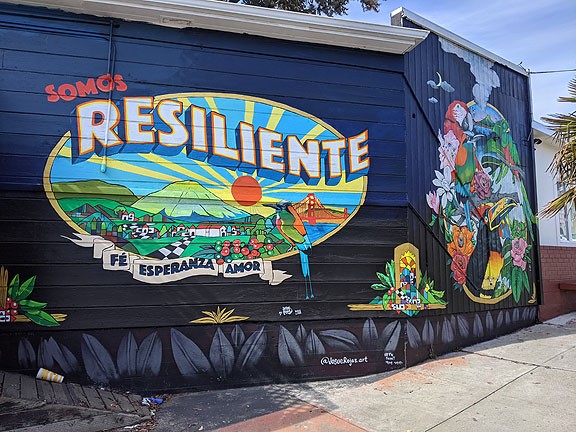
Josue Rojas’s lovely mural at the southern edge of San Francisco.
The end of the world is one path. But worlds have ended many times previously. What has colonialism wrought if not the utter destruction of whole worlds? Bifo is clear about this:
…The end of the world consists in the dissolution of the cultural context that makes experience meaningful, shareable. Colonialism has already provoked many ends of the world. Why should we be surprised if the final collapse of colonialism (that some call postcolonialism) coincides with the end of the world itself? … The peoples of the Global South, the native people of the American continents, the Australian aboriginals, the African communities hit by slave deportation, and many others have already known the experience of extinction, when colonization destroyed the context in which common experience was meaningful. (p. 98-99)
When I read this I found it startlingly on point. Another recent book that I highly recommend is Bad Indians: A Tribal Memoir by Deborah Miranda (Heyday Books: 2013). It’s an incredible kaleidoscopic, emotional, sardonic, wry, and poignant excavation of her own family history as well as a broader look at the history of California Indians.
The original acts of colonization and violence broke the world, broke our hearts, broke the connection between soul and flesh. For many of us, this trauma happens again in each generation, to children too young and too untrained to try to cope with dysfunction that ravages even adults… the formation of a Mestiza Nation was as much about healing from our childhoods as healing from larger histories. I am of the seventh generation since my great-great-great-great-great-great-grandparents Fructuoso Cholom and Yginia Yunisyunis emerged from Mission San Carlos de Borromeo in Carmel, California, in the mid-1830s. I am half white, half Indian, mixed with Mexican and Jewish tribes. (p. 123)
If we allow the pieces of our culture to lie scattered in the dust of history, trampled by racism and grief, then yes, we are irreparably damaged. But if we pick up the pieces and use them in new ways that honor their integrity, their colors, textures, stories—then we do those pieces justice, no matter how sharp they are, no matter how much handling them slices our fingers and makes us bleed. (p. 135)
The dire stories of her childhood and long journey to this self-awareness make this book a very compelling read. The tone she strikes is exactly the note I’ve been encountering more frequently in the past two years than ever before—that California Indians are still here, perhaps in fragmented and sometimes hybrid identities, but actually thriving and growing in ways that have an important role to play in shaping our collective future. While some may follow European intellectual tradition(s) into the cul-de-sac of despair and resignation, people with a lot more justification for despair keep finding ways to reconnect to the generational flow that wasn’t vanquished, did not end, and is creatively forging a new future.
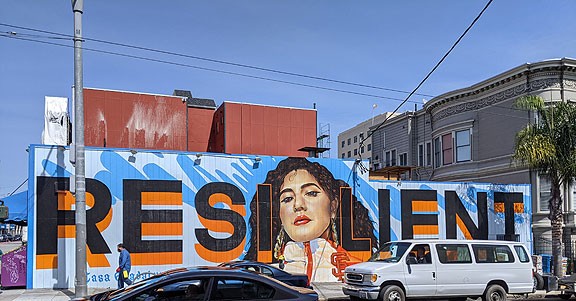
A recurring theme…
Even during the early years of Spanish colonization, there was resistance. While death rates soared at the San Francisco Mission to double the normal rates in the first years (according to Randall Milliken’s indispensable A Time of Little Choice: The Disintegration of Tribal Culture in the San Francisco Bay Area 1769-1810) , mortality increased even more a decade after the Spanish arrived.
At Mission San Francisco the crude death rate for 1785 climbed eighty percent above that of the previous year, although there was no particular concentration of deaths in any short period of time… At San Francisco mortality rates leveled off from 1786 through 1791 (the average yearly crude death rate was 100 per 1000). … Such situations—high mortality rates due to a wide variety of fevers and diarrheal diseases—were not unique to the California missions in the seventeenth and eighteenth centuries. Those were times of increased communication between Europe, Africa, and America, and thus of repeated epidemic outbreaks worldwide, especially in urban areas with concentrated populations of poor people (Dobson 1989:418). But the death rates at missions Santa Clara and San Francisco over the decades between 1780 and 1830 were among the highest continually sustained death rates anywhere. (emphasis added) At its peak in May 1806, a measles epidemic at Mission San Francisco killed 70% of infant males and ALL single girls under 5 years of age. Almost half of the adult women died and 20% of the men. (p. 90-92)
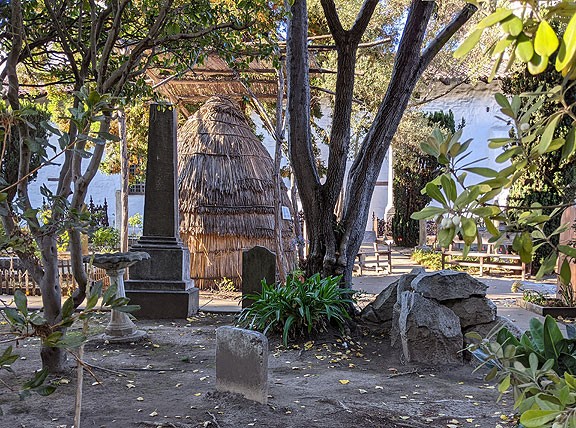
A replica Yelamu hut in the Mission Dolores cemetery.
Still, while enduring the loss of culture, food sources, and finally meaning itself, people fought back. In the brilliant new book We Are The Land: A History of Native California by Damon B. Akins and William J. Bauer (UC Press: 2021), they provide a richly detailed new history of California from the indigenous point of view. (Bauer is himself an enrolled citizen of the Round Valley Indian Tribes in Mendocino County.) “In 1795, two hundred Indigenous People left Mission San Francisco with some of the mission’s horses. Once in California’s interior, absconding Indigenous People taught others how to ride horses and revealed the weaknesses in the mission’s defenses.” (p. 81).
In March 1847, raiding parties of between one hundred and two hundred Indigenous People swept along the California coast, stealing horses. Other Indigenous People raided San Juan Bautista and fired arrows at the settlers, who lacked guns and ammunition after the war. In April, Indigenous People raided San Francisco Bay daily. In one such attack, they made off with two hundred horses.(p. 131)
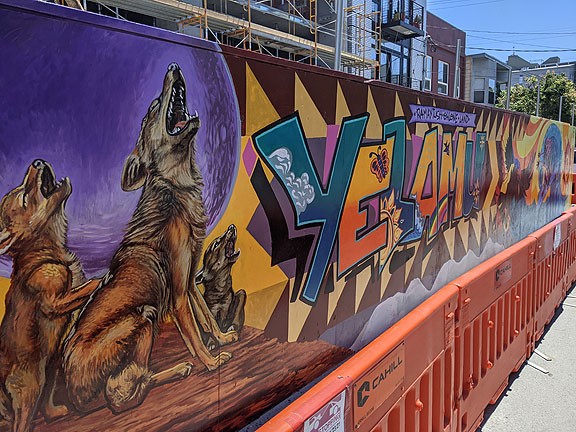
We searched for coyote murals for a few years… suddenly there appeared several!
A similar story that takes place chronologically between the two previous ones is told in Lisbeth Haas’s fascinating study of southern California indigenous history Saints and Citizens: Indigenous Histories of Colonial Missions and Mexican California (UC Press: 2014). After the new Mexican Commissioner circulates among settlements in Alta California in 1822 announcing that Indians would have liberty and equality under the new Mexican constitution (enacted October 4, 1824) and become citizens, conservative friars complained that he had “corrupted” at least a quarter of the mission population.
They wanted to return to their own ancestral spaces. Short of that, they envisioned claiming the missions, where they had created self-sustaining situations and shared elements of culture. The population at the missions shared a space forged through generations of labor. They kept their ancestral homelands, leadership, lineages, and language present while at the missions. (p.158)
Yokuts people, who lived in and around the southern San Joaquin valley, beyond the reach of Mexico’s Alta California regime, engaged in systematic raiding of the missions.
By the 1830s the rates of horse stealing from towns and ranches had reached unprecedented proportions. The Yokuts were not alone. San José lost almost all their horses to raids in 1832. Violence against Yokuts increased. … Few officials contained the civilian violence; indeed, they supported it in their raids against villages they considered to have instigated hostilities or harbored thieves. (p. 178)
After a malaria epidemic brought by trappers from the Hudson’s Bay Company swept the Central Valley, raiding declined for a couple of years, only to resume in 1836. “Those who remained in their territories in the valley, or who moved as fragmented groups to ally with others, kept Mexican society from expanding very far beyond the parameters that existed during the colonial era.” (p. 178) In the Bay Area, where the original inhabitants had been dispersed from their lands stretching 80 miles inland from the coast and 40 miles north and south of the edges of the Bay, Ohlone reoccupied old places during the early American period. Akins and Bauer offer a description that confirms an 1870 map I once saw on the wall at the Peralta Hacienda in east Oakland, showing an “Indian Village” along Alameda Creek south of Dublin along the hills:
Ohlones reestablished a community at Alisal, in Pleasanton. Initially party of the Rancho Valley de San José land grant, in the late nineteenth century Phoebe Apperson Hearst, wife of mining magnate and US senator George Hearst, purchased the land. Hearst sympathized with Ohlones and allowed them to live and work at Alisal. Americans named the rancheria the Verona Station Community. Ohlones integrated the Ghost Dance and the World Renewal Ceremony with local dances and ceremonies. They remained connected to other nearby sites at Niles and Sunol. (p. 301-302)
Failed efforts to have the government purchase the land on behalf of the Verona Band led to their eviction and dispersal in 1919 on the death of Mrs. Hearst. Today the tribe is still seeking federal recognition as Muwekma Ohlone, and the former village at Alisal is buried under the manicured grounds of the Castlewood Country Club.
Finally, back to Bifo. I loved this early thought in his book, which for me feels like an apt conclusion:
The massive talk of death, the resonance of death in the pandemic imagination, may provoke a depressive effect on the psychosphere—or quite the opposite, it may reactivate our sense of time as enjoyment rather than as the economic postponement of joy. (p. 19)
As I’ve been saying for almost 40 years, inspired by someone in the wider radical circles in the early 1980s who coined it first, I’m “for full enjoyment, not full employment!” With extinction occupying the ever closer horizon, a “time of little choice” is rapidly approaching. Why not take advantage of the still expansive possibilities to reorganize and redesign our lives in some kind of harmony with natural systems, with a society of mutual respect and mutual aid, with dignity and a full life assured for everyone? We know the world as it is blocks every sensible move to reorient ourselves. How will a new shared subjectivity, a common project of revolutionary change, emerge from the growing wreckage?
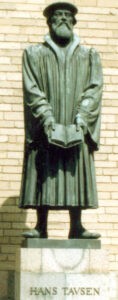
Statue of Hans Tavsen in Ribe, Denmark, where he was the religious leader in the early 1500s and brought the Lutheran Reformation to Denmark.
Perhaps this IS the end of a cognitive universe based on a narrow conception of linear time, endless expansion and economic growth, unlimited resources, and white supremacy to dominate it all. The multi-generational perspective that Deborah Miranda was able to access shifts our sense of time and our place in its stream. How do we connect with the generations that preceded us? What can we leave for those that are coming? In my case I have two beautiful granddaughters who will be 83 and 80 in the year 2100… what will this world look like by then?
Think back seven generations if you can. Thanks to my mother’s father, Henry Wohnsen of Copenhagen, I have a couple of branches of my family tree traced back five hundred years! My ancestors in that seventh generation, at least along one branch of my family tree that has been traced, were farmers on the Danish island of Samsø. A more recent ancestor became harbormaster there. On another branch going back 12 generations to the early 1500s, my direct ancestor was Hans Tavsen, the religious figure who brought the Lutheran Reformation to Denmark.
It’s easy to feel that since my mother was a Danish immigrant in the 1950s, and my father’s father was a Swedish immigrant in the 1920s, that the white supremacist regime here is not something my family helped to build. But that belies all we know about the hidden and blatant advantages of whiteness which accrue to people like me regardless of the multi-generational past. The Danes at least were fully involved in the slave economy. William Leidesdorff has been feted as the founding Black Californian—a mixed race man born of a Danish sugar foreman and a biracial woman in St. Croix when it was still a Danish sugar colony in the early 1800s. Perhaps this Danish link to early San Francisco helps underline the interconnectedness of these migrations that together produced this world, this terminal epoch for a global “civilization” that has gone far off the tracks by staying on the wrong track for so long.
I hope this is the End—of pointless work, of learned helplessness, of a world without empathy, a world without memory… I hope it’s the beginning of the End of a world that should’ve ended centuries ago.












Interesting. Would love to discuss further some day.
Here’s hopin’
You’re never blue
In the year
Twenty twenty-two
Happy new year stay well
Yes!!!